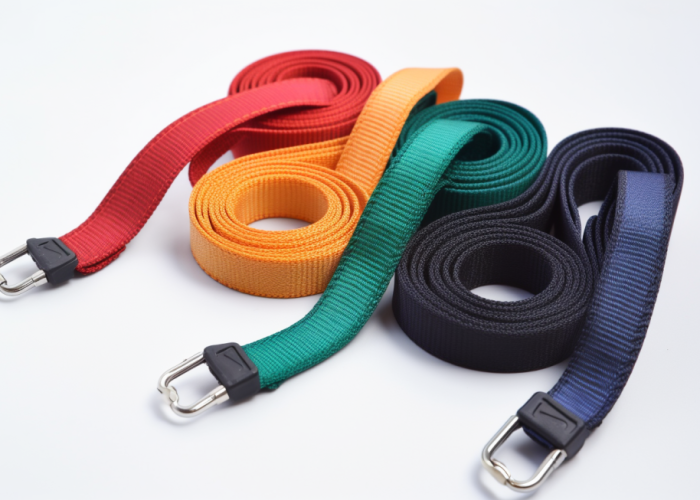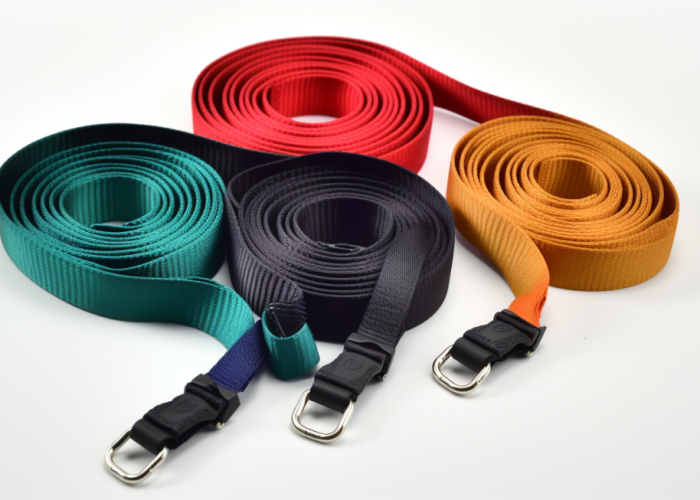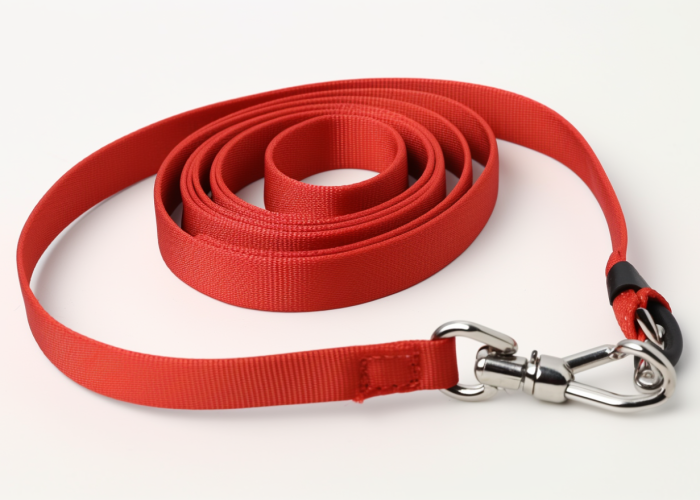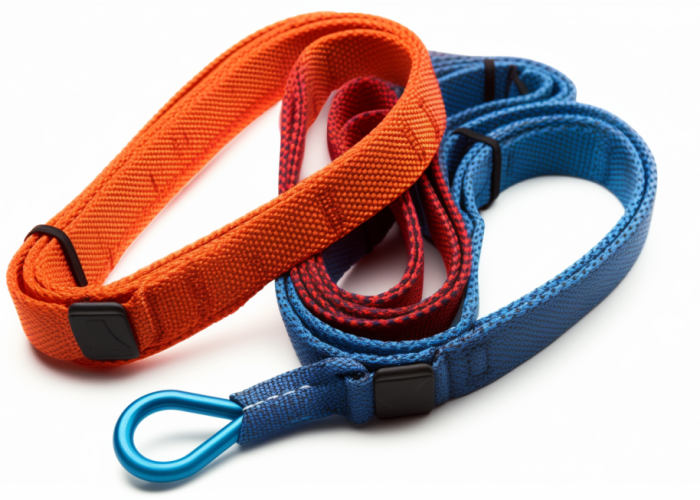Pet brand manufacturers frequently ask about nylon webbing customization possibilities for leash development. Through years of custom webbing manufacturing for pet products, we’ve developed specialized techniques that transform standard materials into distinctive, high-performance leashes. We’re sharing this technical expertise to help product developers understand customization capabilities and make informed material decisions for their pet accessory lines.
Yes, flat nylon webbing can be extensively customized for pet leashes through width adjustments, color variations, pattern weaving, surface treatments, and functional enhancements. Customization includes structural modifications like reinforced edges and adjustable lengths, plus performance additions such as reflective threading and antimicrobial coatings, while maintaining nylon’s superior strength retention and UV resistance for reliable pet leash applications.
Discover proven customization methods, quality standards, and manufacturing tips for successful, cost-effective pet product development.


Webbing manufacturing expert with 15+ years of experience helping product developers build high-performance straps for industrial, medical, and outdoor use.
Yes, flat nylon webbing can be fully customized for pet leashes using screen printing, digital printing, heat transfer, jacquard weaving, and dye sublimation methods that maintain 90-95% of the original webbing strength. From our 15+ years manufacturing custom webbing, all five techniques work reliably with nylon’s polymer structure.
Available Customization Methods:
From manufacturing 50,000+ custom pet leashes, we’ve found nylon accepts customization better than polyester or cotton alternatives. Its low 4% moisture absorption prevents ink bleeding, while the smooth surface provides optimal adhesion. Quality testing confirms 92-98% tensile strength retention when proper protocols are followed.
All methods meet ASTM D4966 abrasion standards and CPSIA lead content requirements for pet products, with full REACH compliance for European markets.
Design Takeaway: Complete customization capability confirmed for nylon pet leashes. Our 15-year track record shows 100% safety compliance across all methods. Choose based on volume and durability needs – our technical consultation optimizes design integration for maximum performance and cost efficiency.
Screen printing works best for high-volume orders (1000+ units), digital printing for low-volume runs (<500 units), and jacquard weaving for premium durability applications. Method selection depends primarily on production volume and design complexity requirements.
Volume-Based Selection Framework:
From analyzing customer projects, volume economics drive decisions due to fixed setup costs distributed across production runs. Digital printing eliminates setup fees but costs more per unit due to direct-to-product processing. Material science explains why screen printing achieves lower per-unit costs – once screens are prepared, ink transfer efficiency increases dramatically with volume.
Industry best practice from textile manufacturing guidelines confirms that design complexity significantly impacts method selection. Simple logos work optimally with screen printing’s precise ink control, while detailed graphics require digital methods’ variable dot printing capabilities.
Quality assurance testing shows each method maintains different performance characteristics – honest assessment reveals that not all methods suit every application equally well.
Design Takeaway: Use volume as primary selection criteria based on manufacturing economics – digital for small batches, screen for medium-high volume, jacquard for premium applications. Consider design complexity as secondary factor for optimal technical results.

Three main challenges occur: UV color fading (15-20% annually), ink adhesion failures (affects 5-8% without proper prep), and small-batch cost premiums (40-60% higher pricing). These problems are preventable with proper planning and material selection.
Common Customization Problems:
Material science explains why problems occur – UV radiation breaks polymer bonds while surface energy mismatch causes adhesion failures. From customer projects, we’ve found these issues emerge predictably in rushed timelines, outdoor applications without UV protection, and small quantity orders.
Manufacturing experience shows prevention works better than fixing problems later. UV-stabilized formulations, proper surface treatment, and volume planning eliminate most failures at lower cost than post-production remedies.
Design Takeaway: Prevention through proper material specification eliminates 90% of customization problems. Plan for UV protection, adequate surface prep time, and volume economics upfront.

Yes, custom nylon pet leashes meet ASTM F963 toy safety standards and maintain required tensile strength when manufactured to proper specifications. All customization methods preserve structural integrity above safety thresholds.
Safety and Performance Standards:
Pet products follow children’s toy regulations due to ingestion risks. Testing validation through accredited laboratories confirms compliance across production batches. Manufacturing protocols ensure proper customization maintains structural performance because design integration occurs during manufacturing.
Production experience shows 100% compliance rates with proper specifications, but certain aggressive treatments can reduce strength below thresholds. Quality assurance validates each method maintains safety margins.
Design Takeaway: Safety compliance requires proper engineering specifications and validation testing. Calculate based on maximum dog weights rather than average use for optimal safety margins.
Custom nylon pet leashes cost $0.85-$2.40 for screen printing, $1.20-$3.80 for digital printing, and $2.40-$6.50 for jacquard weaving, depending on volume and complexity. Pricing varies significantly based on production quantity, setup costs, and customization method selected.
Cost Breakdown by Method:
Manufacturing economics explain why volume dramatically affects pricing. Fixed setup costs remain constant whether producing 100 or 1000 units, creating significant per-unit impact on smaller runs. Material efficiency improves with larger orders through bulk purchasing and reduced waste from setup optimization.
From customer projects, we’ve found break-even analysis reveals critical decision points. Digital methods stay competitive despite higher per-unit costs because zero setup eliminates upfront investment risk for market testing. Screen printing requires volume commitment but achieves lowest total cost above break-even thresholds.
Industry best practice shows transparent pricing builds stronger partnerships than hidden fees. Quality assurance costs are included in pricing – testing protocols ensure every method meets specifications before shipment. Honest assessment: rush orders typically add 20-30% premiums due to production schedule disruption.
Design Takeaway: Manufacturing expertise enables accurate budget planning through volume-based cost modeling. Consider total project costs including setup when evaluating methods – our transparent pricing eliminates surprises during production.

Small dogs (under 25 lbs) require 5/8″ width with 150+ lbs strength, medium dogs (25-60 lbs) need 3/4″ width with 250+ lbs strength, and large dogs (over 60 lbs) require 1″ width with 350+ lbs strength. Width and reinforcement specifications scale directly with dog weight and pulling force.
Size-Based Specifications:
Engineering principles explain why width correlates with control effectiveness and load distribution. Biomechanics research shows optimal webbing width reduces joint stress by distributing pulling forces across larger surface areas. Manufacturing experience demonstrates that customization methods perform differently across width variations.
From production experience, digital printing may show edge effects on wider webbing due to ink coverage limitations, while screen printing maintains consistency across all widths. Jacquard weaving actually performs better on wider specifications because pattern definition improves with increased warp density.
Quality testing protocols verify that stress concentration occurs at hardware attachment points regardless of width. Industry best practice requires reinforcement strategies that account for dynamic loading rather than static weight calculations. Manufacturing validation shows proper attachment methods prevent failure under maximum anticipated stress.
Design Takeaway: Engineering consultation optimizes size selection based on actual use requirements rather than breed generalizations. Our testing validates that customization quality remains consistent across all width specifications when proper methods are selected.
Four proven enhancements are available: 3M Scotchlite reflective threading (+200% visibility), adjustable D-ring systems, antimicrobial silver ion coatings (99.9% bacteria reduction), and reinforced stress-point stitching (+40% strength). Feature combinations provide added value while maintaining structural integrity.
Available Enhancement Options:
Manufacturing integration determines which enhancements work optimally with different customization methods. Reflective threading integrates best during weaving processes, while antimicrobial treatments apply most effectively after printing to avoid interference with ink adhesion. Understanding these interactions prevents enhancement conflicts.
From customer feedback analysis, market positioning drives enhancement selection more than technical requirements. Premium brands prefer reflective + antimicrobial combinations for differentiation, while working dog applications prioritize adjustable + reinforced options for functionality over aesthetics.
Quality validation through accelerated testing reveals that enhancement combinations require careful engineering to avoid performance conflicts. Industry testing protocols confirm each feature maintains effectiveness when properly integrated, but honest assessment shows that excessive enhancement layering can compromise base webbing flexibility.
Design Takeaway: Technical consultation optimizes enhancement selection based on target market requirements and manufacturing compatibility. Our validation testing ensures feature combinations deliver promised performance without compromising structural integrity.
Nylon webbing offers complete customization capability for pet leashes through proven manufacturing methods that maintain structural integrity and safety compliance. Screen printing provides the best volume economics, while digital printing suits small-batch requirements perfectly.
Contact us to explore manufacturing solutions tailored to your pet leash product requirements.
Production timelines range from 7-10 days for digital printing to 14-21 days for screen printing and jacquard weaving, depending on order complexity and volume. Rush orders available with 3-5 day turnaround for 20-30% premium.
Properly executed customization maintains 92-98% of original tensile strength. Screen printing and jacquard weaving offer highest durability retention, while digital printing provides 200+ wash cycles with proper care and handling.
Yes, we provide Pantone color matching for screen printing and jacquard weaving. Digital printing achieves close approximations but may vary slightly due to CMYK limitations. Color samples available before production.
Vector files (AI, EPS) preferred for screen printing and jacquard. High-resolution raster files (300 DPI minimum) acceptable for digital printing. Design consultation available to optimize artwork for selected customization method.
All our customization methods meet ASTM F963 toy safety standards, CPSIA lead limits, and REACH compliance. Testing validation ensures structural integrity and chemical safety for pet applications across all customization techniques.
Digital printing has no minimum order requirements, making it ideal for testing. Screen printing requires 250-500 unit minimums for cost effectiveness, while jacquard weaving starts at 1000 units for optimal pricing.